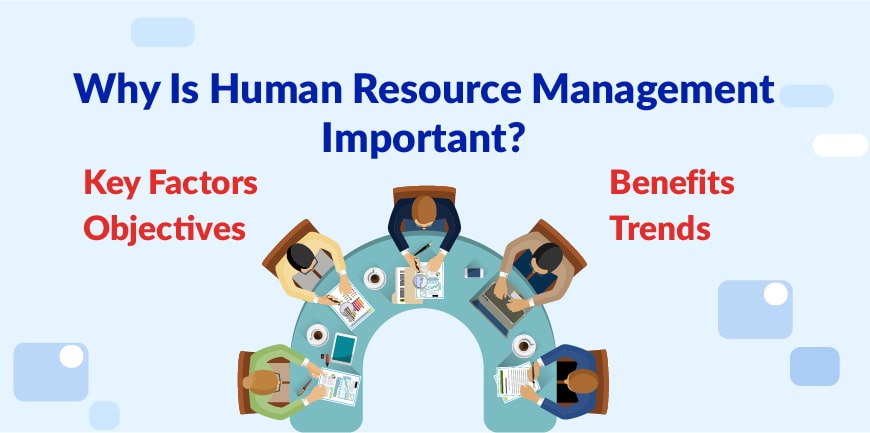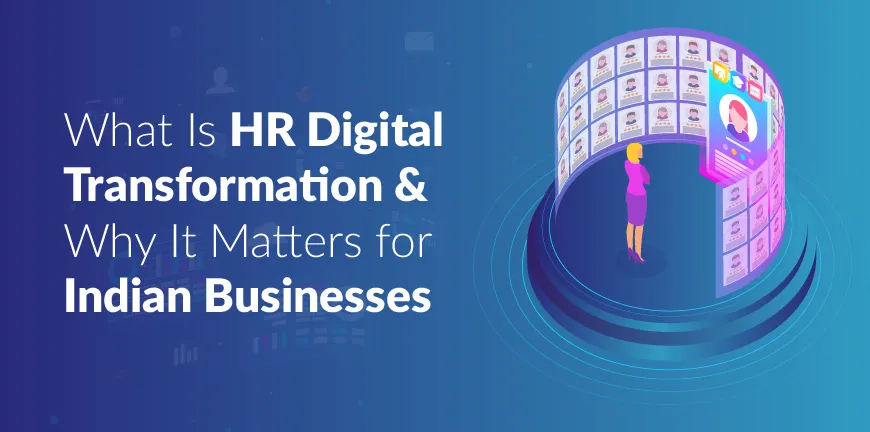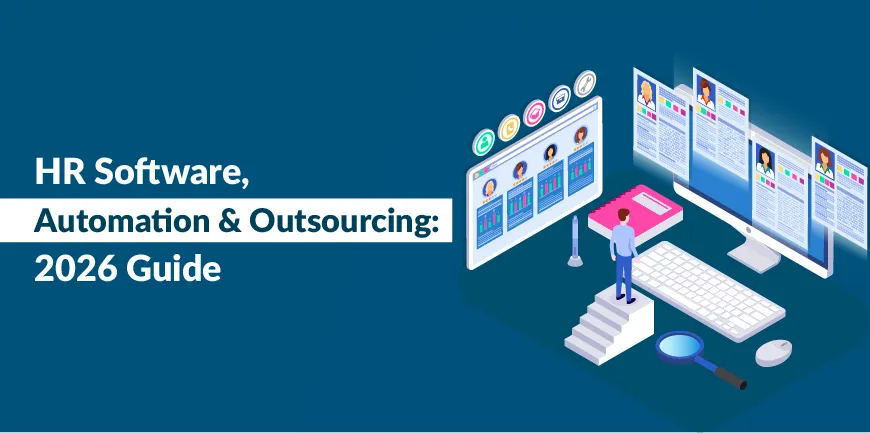
What is a Head-hunter? Meaning, Definition, Types, Benefits, Methodology
09/06/2025
What’s the difference between Permanent and Contingent Workers?
11/06/2025- What is Human Resource Management?
- What Is the Importance of Human Resource Management for Organizations?
- What Are the Key Functions of Human Resource Management?
- How Does Human Resource Management Benefit Employees?
- What are the Objectives of Human Resource Management?
- What are the Human Resource Management (HRM)Trends?
- Frequently Asked Questions (FAQs)
If you thought an HR’s work ends after recruiting an employee, then you are sorely mistaken, because the real work starts post the recruitment. The human resource management function encompasses managing these recruited employees and the existing employees for their entire duration in the company. The function of managing employees is not only challenging but is also crucial to ensure an organization’s success.
In this article, we’ll be exploring the importance of human resource management, how it works, and the current trends.
What is Human Resource Management?
Human Resource Management is the process of managing employees or talent in an organization. This is a crucial function as it facilitates an effective alignment between employees’ performance and organizational goals and objectives. HRM encompasses various functions like recruitment, training, compensation, and employee relations, all of which when carried out perfectly leads an organization towards success.
What Is the Importance of Human Resource Management for Organizations?
Effective human resource management is the backbone behind every organization’s success. It has become one of the most valuable functions in an organization as it adds strategic value and possesses a strong hold on the company leadership teams. The importance of human resource management in most organizations comes down to having skilled and engaged people who are aligned with organizational goals.
Some of the main ways in which the function adds value to an organization is-
1. Support through the employee lifecycle
Human resource management involves the hiring, training, and managing employees right from their recruitment till their exit stage.
2. Better cost management
According to an estimate, 70% of an organization’s expense includes labour costs which comprise of their salaries, benefits, payroll taxes and more. By crafting the right policies, deciding the right pay and benefits and by providing analytics that help organizations create better budgeting leading to better decision making, HR management helps keep costs under control.
3. Positive work culture
A strategically carried out human resource management gives importance to training, development, work-life balance, diversity, and inclusion initiatives, all of which play a crucial role in deciding the productivity of an organization by boosting employee engagement and retention.
4. Reduced compliance risk
Effective human resource management helps organizations comply with the may labour laws that dictate rules and regulations of employment set by the government. HR management teams reduce the hiring risk through onboarding, employee communication programs and surveys along with providing compliance support.
What Are the Key Functions of Human Resource Management?
So, how does HRM work? To curate an effective human resource management strategy, you must have a good mix of recruitment strategies, compensations plans and communication and team building.
1. Talent Acquisition
Talent acquisition is one of the most significant functions of HRM. The talent acquisition function encompasses every part of the recruitment cycle- recruiting, hiring, and retaining talent. The HR department may be responsible for hiring talent. But attracting talent largely depends on the employer brand reputation. An excellent employer brand attracts about 50% more qualified applicants.
2. Recruitment
A tactful HR professional analyses the market and sets a competitive salary range before diving into the promotion of the company’s available positions on various platforms. As the applications start to flow in, the screening process commences before deciding on the final list of candidates whose profiles qualify for the next round/ several rounds with managers and other senior leaders as required.
3. Hiring
An HR manager plays an important role in Human resource management as he helps carry out core tasks-completing background checks, employee onboarding, payroll management, benefits, and compensation regulation policies. There is a lot of legal, documentation work and other formalities involved in the hiring process, all of which must be satisfied, during the onboarding stage.
4. Retaining talent
Happy, satisfied employees translate to the growth of the business. Any good HR understands that having employees stay is as crucial as recruiting them and cannot be overlooked. Four critical factors that contribute to employee satisfaction:
- How respectfully were employees treated at all levels?
- Good employee-employer relationship
- Opportunities to showcase their skills
- Compensation/benefits
5. Employee Engagement
Employee engagement is often overlooked in many organizations even if they know it leads to dissatisfaction, demotivation, and abrupt exiting of employees. An important role of human resource management is to achieve desired employee engagement by encouraging them to discuss concerns or report situations that they view as problematic before they can snowball into harmful conditions.
- Organizing rewards and recognition programs
- Encouraging feedback
- Organizing gatherings
- Engaging in policies that align with the employees’ needs
- Mediate or resolve conflicts
6. Performance Management
Maintaining or improving employee job performance is as essential as recruiting good ones. It is usually done with the help of specific assessment tools, counselling and encouraging feedback. Evaluating, Coaching, and rewarding employees based on their performance and individual/team contribution is an essential aspect of employee engagement, playing a vital role in performance management and helping boost individual/team/department/organization productivity.
7. Compensation and Benefits
Compensation and benefits plan a significant role in ensuring employee satisfaction and retention. Creating competitive and attractive offers that align with the candidate’s expectations but also the budget of the organization is a big part of human resource management.
Compensation and benefits include- Health insurance, Education benefits, Parental leave, referral bonuses, sign-on bonuses and more.
8. Training and Development
Fostering employee skills and providing them opportunities to learn and grow professionally is a big part of HR’s responsibility. Providing employees with training and development programs harbour positive effects on employee productivity, enhances performance and lead to reduced turnover rates.
The training is not just for individual growth but a strategic one that aligns with the organization’s short-term and long terms goals and responsibilities. There is a wide range of topics for which the HR organizes informational sessions and seminars –
- Diversity, equity, and inclusion
- Reporting any sexual harassment
- Newest industry and market trends
- New technology
9. Effective Risk Management
Every business is prone to risks. Keeping the interests of the employees and the company in mind, assessing, and resolving those risks before they become real threats is a pivotal function of human resources. What role does HRM help?
- By giving the proper form of training to managers and collecting feedback from the direct reports
- Taking suitable measures to maintain diversity
- Making sure all the data and sensitive records are safe and secure by constantly working along with the IT department
- Ensuring all employee records are protected and updated as and when necessary
- Staying alert and recording any complaints that come their way- allegations of harassment, sexism, or any sort of unfairness amongst the employees.
10. Maintaining Audits and Legal Compliance
Business labour laws are rather complex and tend to change very often. Laws on labour, compensation, hiring, and benefits are subject to change periodically. A successful business ensures that its organization follows and keeps itself updated about the state, federal and local laws, and regulations necessary for the firm.
Non-compliance with labour laws can cause risk in several areas –
- Inadequate maintenance or personnel files
- Poor record retention
- Inaccurate records related to wages/hour/time
A seasoned HR department is aware of all labour and compliance laws.
How Does Human Resource Management Benefit Employees?
Human resource management is not only crucial for organizations to maintain operational productivity but also benefits employees in several ways. Let’s see how-
1. A safe and fair workplace
HRM makes sure that organizations comply with labour laws and regulations, ensuring fair practices, eliminating discrimination in the workplace, and providing them with a safe place to work. Additionally, make sure your employees are provided with a channel to raise their concerns. Solve disputes quickly.
2. Promote employee growth and development
HR teams keep in touch with employees and make sure they are provided with the right opportunities and training programs to advance in their careers. By developing a friendlier relationship HR professionals help employees understand their performance expectations and provide feedback for improvement. If needed, a coach or a mentor is provided to help guide employees.
3. Provide financial and well-being support
HRs take care of disbursing employees’ salaries on time including benefits, like retirement plans, health insurance etc. Employees can even seek advice on personal or work-related challenges they are facing. To ensure employees are keeping themselves mentally healthy, the team implements wellness programs.
4. Enhance work-life balance
By speaking to the higher hierarchy, the HR even ensures there are policies related flexible work arrangements included in the employee handbook. HR ensures they avail paid time off and implement initiatives like employee resource groups to facilitate healthy work life balance.
5. Boost employee engagement and satisfaction
HRM plays a significant role in fostering a friendly environment in the workplace. They go about this by promoting a culture of diversity and inclusion and making everyone feel important. HRs make sure there is communication between the employer and employee when needed. This ensures a boost in employee morale.
What are the Objectives of Human Resource Management?
The aim of human resource management is to make sure that employees are happy and satisfied with their work and workplace while ensuring their efforts result in productivity of the organization.
- Achieve organizational goals- HRM makes sure that the performance of employees aligns with organization’s goals and objectives.
- Integration of teams- The HR plays a major role in ensuring a team is working together and collaborating successfully by using effective communication.
- Training and development- HRM makes sure employees don’t feel stifled in their jobs and provide them with the required training to excel in the jobs
- Provide resources- HRs facilitate the inclusion of employees when it comes to making decisions in the organization by providing them with the resources
- HRM ensures that enough opportunities are provided to employees to help them grow as well as retain them in the organization.
What are the Human Resource Management (HRM)Trends?
The current HR trends are going to shape the future of HR practices. These trends will be driven by advancements in technology, changes in workforce expectations and evolving business needs.
1. Leadership development and succession planning
As organizations become more dynamic, there is an increasing need for leadership programs that can build agile, empathetic, and savvy leaders.
2. Redefining EVP
Your employees are your company’s most significant assets and in order to retain your assets, companies need to think of providing them with a reason to stay. You must take care of your employees’ needs, whether its training, encouraging career development, providing job security, or giving their opinions a good ear and respect them.
3. Use of Generative AI, Automation, and data
The use of Artificial intelligence in the recruitment process is expected to grow more in the coming years with AI tools performing tasks like screening resumes, assessing candidates and even conduct basic interviews using natural language processing.
4. Hybrid work models
As for HR professionals, they need to look beyond just working from home as an employee benefit. With more and more employees working from different locations, there has to be more focus on compliance with regional labour laws, taxation, and benefits.
5. Upskilling, reskilling, and promotion of internal mobility
Provide employees with opportunities to grow professionally and boost their career growth. Not only will it help with employee retention but will also boost employee engagement, which plays a significant role in deciding the productivity of an employee.
6. Diversity, Equity and Management
With the use of data analytics, HR can monitor, measure, and improve their diversity and inclusion initiatives. HR teams will be hiring candidates by eliminating all bias associated with gender, ethnicity, culture, race, and sex and help build a more diverse workforce.
7. HR- a strategic business partner
There has been a newly formed alliance between the CHRO and CEOs making HR as part of business-related decisions as they know more about operational activities, changes in productivity levels, budget strains, etc…
Human resource management is the backbone of an organization that ensures employee satisfaction and organizational growth. The absence of a proper HRM setup can give rise to many serious problems in an organization due to the mismanagement of regular activities, which is why setting up a strong and effective HRM is vital for any business to thrive.
Frequently Asked Questions (FAQs)
1. Can small business use HRM?
It doesn’t matter if your business is small or big, having HRM is vital for every organisation’s growth, success, and operational continuity.
2. What is the importance of human resource management?
Effective human resource management is the backbone behind every organization’s success. It has become one of the most valuable functions in an organization as it adds strategic value and possesses a strong hold on the company leadership teams.
3. What are the main functions of HRM?
The main functions of HRM include- recruitment, employer branding, onboarding, compensation and benefits, analytics and reporting, training, employee relations, diversity, equity, and inclusion initiatives.
4. Why is employee engagement important in HRM?
Employee engagement improves work culture, reduces turnover, increases productivity, builds better work and customer relationships, and affects profits.
5. How does HRM help with legal compliance?
HRM plays a crucial role in ensuring legal compliance by implementing policies, providing training, and conducting audits to stay informed about employment laws and regulations.
6. What are the benefits of strategic human resource management?
The significance of strategic human resource management lies in the fact that it not only tells you how to aim for something but also estimates what targets to aim for and justifies why to take aim. In this way, strategic human resource management becomes important – by developing an understanding of why an HR function is important, how to better use that function and for what purpose, and how to accomplish what you want to, in the best way possible.
Contact Us For Business Enquiry

Rajkumar Shanmugam
Rajkumar Shanmugam is the Head of HR at ALP Consulting, bringing over 19 years of comprehensive HR leadership experience across India and international markets. His expertise spans talent acquisition, employee relations, performance management, compliance, and HR transformation. Rajkumar has a proven track record of driving people-centric initiatives, enhancing workplace culture, and aligning HR strategy with business goals. With extensive experience in US staffing operations and global mobility, he continues to lead organizational excellence through innovation and employee engagement.




